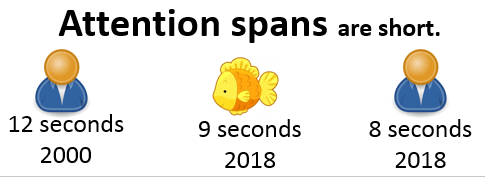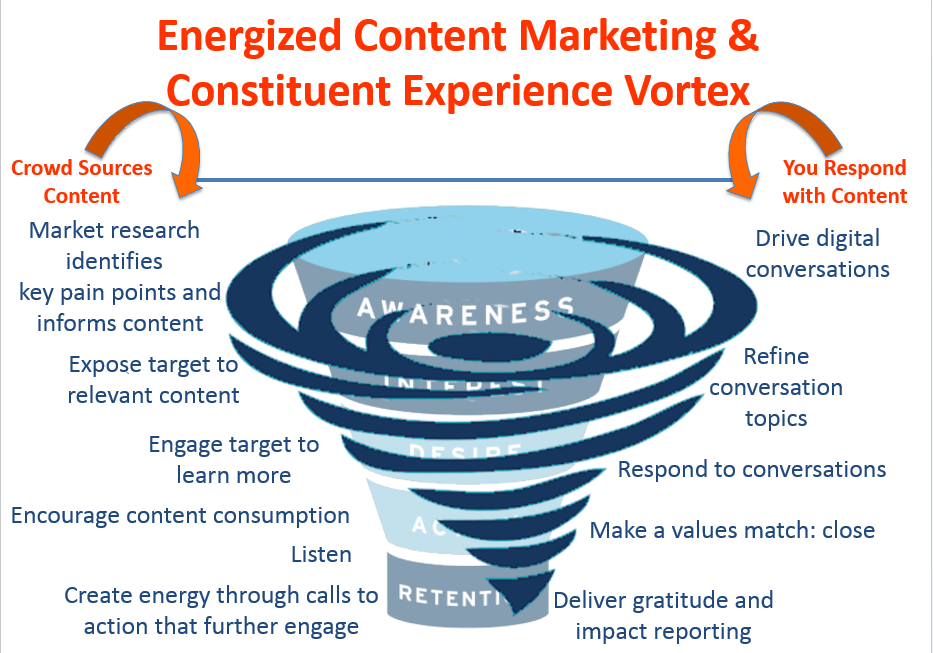
Things not looking as you remembered them?
Or else.
Reframing how you’ve done fundraising in the past is not optional.
It’s time for a change.
You must do it, because fundraising and nonprofit marketing have changed a LOT over the past ten years. There is absolutely no denying this at this point. You need to adapt. Or suffer the consequences.
If you’re still doing the same exact things you did ten years ago, or even five years ago, it’s time to rethink. If you have leaders who doubt there’s a need for change, simply explain the reasons as I’ve outlined below:
1. Changes to do with technology.
The toolkit for fundraisers and marketers has become way more powerful. Never before have there been so many tools to connect with so many customers with such scale and efficiency. And if fundraising staff don’t know about these tools, they can’t ask marketing staff to use them. Google ads. FB hangouts. Social media. There are myriad ways to help your buyer/donor through the research and decision-making process in ways not previously scalable.
More and more you need people on your staff who understand the digital world and digital tools. There are many databases, CRM and email provider solutions out there that didn’t exist a decade ago. If you haven’t upgraded these platforms recently, now is the time to give this some serious thought. You need folks on your team to help you navigate the digital world strategically.
For more on technology’s impact on nonprofit management generally, read Nonprofit Strategy & Management in a New Zeitgeist. For more on the impact on marketing, read Nonprofit Social Media Marketing – What’s Trending and Keeping Up with Nonprofit Content Marketing and Social Media Tools.
2. Changes to do with how people communicate.
And, yes, much of this has to do with technology. You can no longer rely on a single communication channel. Nor are you even in charge of your brand anymore. People will find you, and form opinions about you, long before you’re even aware they exist. Today, buyers are 60-70% through the decision-making process before engaging salesperson.
The world has decidedly shifted from outbound to inbound marketing. Your constituents are more in control. Stop thinking you can just create a pretty newsletter, send it to folks with some text about how great you are, and they’ll respond with a gift. Stop thinking you can tweet about an event and folks will share it virally. You’re lucky if they open their mail or click on your emails. Folks have become adept at blocking out what they consider “noise.” Marketing (which nonprofits used to call ‘development’) is now very much an “outside/in” proposition. It’s not about a gun… blast… our any outward-bound messaging. It’s about inbound dialogue and engagement. Maintaining a dynamic, relevant online persona and presence is critically important.
For more on the shift in marketing due to the digital revolution, read 5 Reasons Why Nonprofit Marketing Must Change from Inside/Out to Outside/In. For more on the need for greater marketing/fundraising integration, read ONE BIG THING Your Nonprofit Must Do TODAY to Succeed. For more on how to actively engage online, read Donor-Centered Digital Communications: How Do You Tailor the Nonprofit Experience?
3. Changes to do with branding.
Your brand is no longer a top-down exercise. As alluded to above, people will learn and talk about you in ways that shape your brand – no matter what you yourself have to say on the matter. So your “about” page matters less than the “testimonials” you sprinkle throughout your website, blog, e-newsletter and social channels. And what people think, and say, about you will largely impact people’s willingness to support you philanthropically. Which is a huge reason fundraising and marketing can no longer be separate silos.
For more on changes to nonprofit branding in our digitally-revolutionized zeitgeist, read Lead Your Nonprofit from Vision, Not Mission. For more on why marketing and fundraising can no longer be siloes, read The Shocking Truth about Marketing and Development for Nonprofit.
4. Changes to do with information overload.
A wealth of information creates a scarcity of attention and thus a need to efficiently allocate attention. We live in the age of information overload. Human attention spans have decreased
 Today’s fundraisers and nonprofit marketers need to share responsibility for grabbing attention, creating awareness, building desire, stimulating engagement and inspiring investment. And they need to make a shift in how they communicate as well. Visuals grab attention much faster than prose, and it’s easier than ever to make a video or share a heart-wrenching or heart-warming image.
Today’s fundraisers and nonprofit marketers need to share responsibility for grabbing attention, creating awareness, building desire, stimulating engagement and inspiring investment. And they need to make a shift in how they communicate as well. Visuals grab attention much faster than prose, and it’s easier than ever to make a video or share a heart-wrenching or heart-warming image.
For more on the trend towards using visuals to grab attention, read Using Visuals to Enhance Nonprofit Marketing & Fundraising.
5. Changes to the path to donor loyalty.
The rigid, linear ‘donor pyramid’ model no longer accurately reflects your constituents’ engagement journey with your organization. If you’re still stuck on forcing folks to climb a ladder or pyramid to get to the pinnacle of philanthropic investment, you’re going to miss out on a lot. For example, the power and influence of your peer-to-peer fundraisers and online advocates. Because of the digital revolution, businesses of all stripes – for- and non-profit — must make the shift to reformulate their marketing and sales (aka fundraising) funnels. In fact, I no longer think of it as a ‘funnel’ but more as an active, energized swirling vortex. You call it what you will, but it looks something like this.
 Your biggest return on engagement today will come from meeting folks where they are.
Your biggest return on engagement today will come from meeting folks where they are.
For more on changes to how attention is grabbed and sustained, read How Social Media Toppled the Donor Pyramid – What that Means for Nonprofits, Yes, The Donor Pyramid is Really Dead and R.I.P. Donor Pyramid?
6. Changes to do with new research and data that should inform your strategies.
You no longer need to guess about a lot of things (e.g., what floats people’s boats; where they come from; what they’re interested in) because you can track this information using a number of analytical tools to leverage your data. There are user-friendly tools to track donor retention, downgrades, upgrades, opens, clicks, shares and the like. Some of these come embedded with CRM reports and database dashboards you purchase. You can also use Google Analytics Google Analytics, Growth-in-Giving charts available for free from the Fundraising Effectiveness Project, or tools such as the complimentary Fundraising Report Card. The more you know about what works/doesn’t work, the more strategic you can be setting goals, objectives and tactics.
To learn more about how to improve your use of data, read 5 Strategies to Improve Nonprofit Use of Donor Data and Is Your Nonprofit’s Data Actionable?
7. Changes to do with changing priorities.
If there was ever a constant in the world, it’s change. Whether you want it to happen or not, it happens. And that means the way you’ve done things in the past won’t always work as well today. Let alone tomorrow. To keep pace you must adapt. And to adapt, you must take stock. What are your key objectives this year? What are your key challenges? What challenges must be addressed to reach your objectives in the current digitally-revolutionized and highly networked world?
To learn more on how to take your own inventory, and re-order priorities, read Address Key Nonprofit Marketing Challenges Head On and Fresh Nonprofit Marketing Ideas: What to Do Differently.
Enroll in Clairification School to Read All My Articles

If I know it, I want you to know it!
If you’re already enrolled, thank you! I couldn’t do this without you.
If you’re not yet enrolled, know when you join us as a Clairification School student, you’ll (1) receive weekly articles direct to your inbox, (2) be able to read all my past articles on a wide range of topics likely to be of interest to one or more folks on your team (staff and volunteer), (3) get access to all my webinars, (4) receive practical monthly tips exclusive to students, (5) get discounts on all Clairification courses and products, (6) receive bonus materials, and (7) get priority attention. I hope this is a no-brainer for you.
The deal: Enrollment is just $100 for 12 months. Your 25 cents/day covers costs, so I can share everything I know and learn. It’s just me here. Not a large corporation. No other staff. Time I spend creating content for you is time I can’t spend doing large consulting projects. That’s okay! I want to help you make our world a better place. You support me, I’ll support you.
NOTE: Many of my articles are like a ‘master class’ on the topic at hand (if you want them to be). They can also be a starting point for discussion among your team. Dig in, or don’t, as per your schedule and interests. Summary of Clairification articles I’ve linked to in this post:
- Nonprofit Strategy & Management in a New Zeitgeist
- Nonprofit Social Media Marketing – What’s Trending
- 5 Reasons Why Nonprofit Marketing Must Change from Inside/Out to Outside/In
- Top 5 Reasons Your Nonprofit Will Fail Absent Inbound Marketing
- ONE BIG THING Your Nonprofit Must Do TODAY to Succeed
- The Shocking Truth about Marketing and Development for Nonprofit
- Using Visuals to Enhance Nonprofit Marketing & Fundraising
- Yes, The Donor Pyramid is Really Dead
- 5 Strategies to Improve Nonprofit Use of Donor Data
- Is Your Nonprofit’s Data Actionable?
- Address Key Nonprofit Marketing Challenges Head On
- Fresh Nonprofit Marketing Ideas: What to Do Differently
- You Say “Potato,” I Say “Patattah”: Development vs. Marketing, Part 1
- You Say “Potato,” I Say “Patattah”: Development vs. Marketing, Part 2
Other articles written by me to which I’ve linked:
- Keeping Up with Nonprofit Content Marketing and Social Media Tools, Maximize Social Business
- Donor-Centered Digital Communications: How Do You Tailor the Nonprofit Experience?, Bloomerang
- How Social Media Toppled the Donor Pyramid – What that Means for Nonprofits, Maximize Social Business
- R.I.P. Donor Pyramid?, Nonprofit Pro






Timely! So timely! Giving a presentation today to Sr Ldrs on why we need engagement strategies with our new CRM.
Claire, tell me, how best to vet engagement strategists? And where to find the approx. costs to build out the work over time?
I’m having difficulty finding the info.
Susan
Glad this was timely for you. Not sure I fully understand your question. If you have already selected a CRM, I’d recommend you start with them to see what resources they offer in this regard. Or feel free to email me separately.